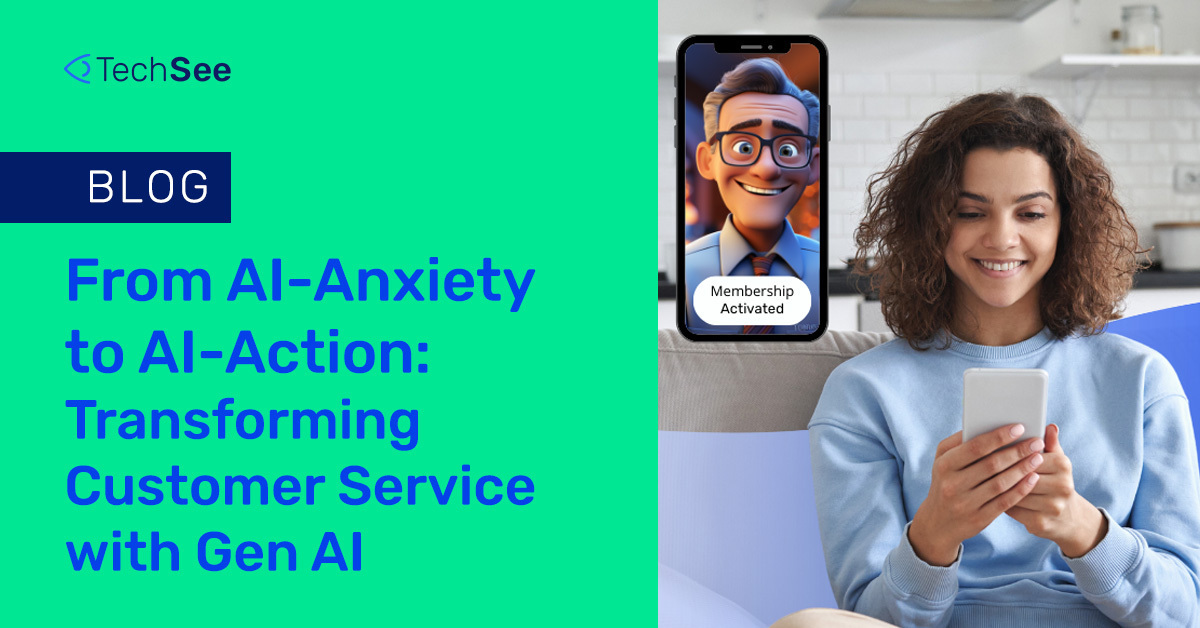Contents
- From AI-Anxiety to AI-Action: Transforming Customer Experience with Gen AI
- The AI Fear Factor: Battling the Unknown
- From Panic to Partnership: AI Augments Human Service
- Data that Calms the Chaos
- A Movie Night Nightmare: AI Could Have Saved the Day
- When AI Falls Short: The Necessity of Human Touch
- Turning Anxiety into Action: Real-World AI Success
- Beyond Fear: AI and Human Ingenuity Creating Exceptional Experiences
From AI-Anxiety to AI-Action: Transforming Customer Experience with Gen AI
Katie Mamia
“In this evolving landscape, the key to overcoming AI-anxiety lies in demonstrating the tangible benefits of AI in action. When customers experience firsthand how AI can simplify their lives and resolve their issues with ease and empathy, their apprehension transforms into appreciation.”
The AI Fear Factor: Battling the Unknown
In our rapidly evolving digital age, artificial intelligence (AI) is both a beacon of innovation and a source of trepidation. The thought of “machines” taking over customer interactions still conjures images of cold, impersonal systems. Yet, as businesses and consumers witness the transformative power of generative AI, this AI-anxiety is beginning to fade. The key to this shift lies in showcasing AI’s tangible benefits, transforming fear into fascination.
From Panic to Partnership: AI Augments Human Service
The essence of this transformation is straightforward: AI should enhance human capabilities, not replace them. Today’s customers seek more than swift responses; they desire genuine solutions delivered with empathy and immediacy. Generative AI, adept at processing and interpreting complex data, helps decode problems and provide clear, actionable guidance, thereby enriching human interaction rather than overshadowing it.
Data that Calms the Chaos
To illustrate this shift from anxiety to action, consider some compelling statistics that highlight AI’s positive impact on customer experience. TechSee’s Sophie Study, which surveyed 880 adults across the US, found that while only 12% use first-generation technology like ChatGPT regularly, 85% of the general public is open to using AI for services and automating manual tasks. This 12% represents a significant room for growth, indicating a large group who are still timid about adopting AI. And that’s okay—it’s part of the journey from anxiety to acceptance.
Despite initial fears, the advantages are clear:
- Efficiency Boost: By 2025, AI-driven customer experience organizations are projected to increase operational efficiency by 25% (Gartner).
- Improved Resolution Times: AI can cut handling times by up to 30% (Forrester).
- Enhanced Satisfaction: AI-driven interactions can elevate satisfaction scores by 20-30% (McKinsey).
- Personalization at Scale: A significant 73% of customers expect companies to understand their needs, a feat AI can achieve (Salesforce).
- Cost Savings: AI implementations can slash costs by 15-20%, making products cheaper for consumers (Deloitte).
*All data used is publicly available.
A Movie Night Nightmare: AI Could Have Saved the Day
Let me share a personal anecdote that underscores AI’s potential and helped me have my “leap of faith moment”. Just last month, my family and I were poised for a cozy movie night when, predictably, the internet failed us. After what felt like an eternity on hold, I finally reached a representative who led me through a series of ineffective troubleshooting steps. Despite my efforts to describe the blinking lights and error messages, it was evident they didn’t fully grasp the issue. If only I could have shown them the peculiar way the router lights were flashing—instead of insisting on their standard steps. The frustration would have dissipated, and our movie night could have resumed swiftly.
The ability to visually convey the issue could have made all the difference. Imagine if AI could instantly analyze millions of similar problems (text, voice, visuals, documents), identifying patterns and solutions in real-time. While I was on hold, AI should have sifted through vast amounts of data, pinpointing the exact issue based on the peculiar way the router lights were flashing. By leveraging this “tribal knowledge,” AI should have tapped into the collective experience of countless individuals who have faced similar issues, providing precise and efficient resolutions.
When I joined TechSee, I saw firsthand how this was not just a possibility but a reality. Integrating AI into our daily lives may provoke some anxiety, but the moments spent with family are worth more than the frustration of avoidable tech issues. AI cuts through confusion, ensuring we spend less time troubleshooting and more time enjoying what truly matters.
When AI Falls Short: The Necessity of Human Touch
Despite its advantages, AI isn’t infallible. There are moments when technology falls short, and the human touch becomes irreplaceable. Striking a balance where AI complements rather than replaces human interactions is crucial. Transparency, fairness, and continuous improvement are key to building trust and making AI a reliable partner in customer experience.
Turning Anxiety into Action: Real-World AI Success
In this evolving landscape, the key to overcoming AI-anxiety lies in demonstrating the tangible benefits of AI in action. When customers experience firsthand how AI can simplify their lives and resolve their issues with ease and empathy, their apprehension transforms into appreciation.
Start small—experiment with AI-driven chatbots, implement AI tools for data analysis, or use AI to personalize customer interactions. The more you see AI in action, the more you’ll appreciate its potential to work for you. Think of it as dipping your toes in the water before diving in; the initial step can ease anxiety and open up a world of possibilities.
Beyond Fear: AI and Human Ingenuity Creating Exceptional Experiences
The future of customer experience lies in the synergy between AI and human ingenuity. By focusing on the real-world applications and benefits of AI, businesses can lead the way in transforming AI-anxiety into AI-action, setting a new standard for customer happiness. We all deserve better service and to be treated as equals—this is a fundamental human right. Knowing that technology can ensure fairness and efficiency helps me sleep better at night.
Looking ahead, it’s clear that the journey from AI-anxiety to AI-action is about more than just adopting new technology; it’s about reimagining how we connect with and serve our customers in a world where every interaction matters. By embracing AI’s potential while maintaining the irreplaceable human touch, we can transform fear into fascination, anxiety into action, and ultimately, enhance the human experience.
To learn more about TechSee’s Sophie AI and how we can help automate and improve your customer experience, please contact us today.






